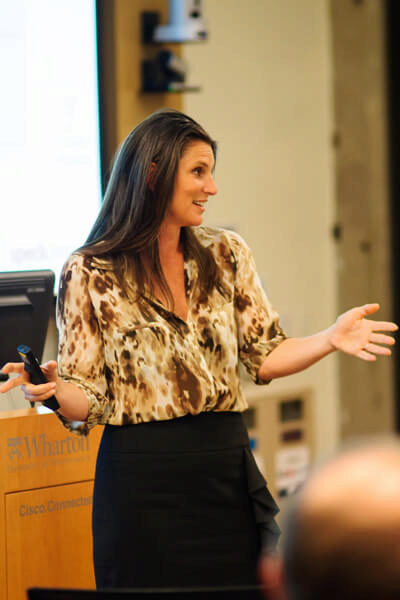On a list ranking near-universal problems in the business world, the difficulty of becoming consistently innovative would surely appear near the top. Somewhere nearby would be the ever-present challenge of creating products and services that offer broad consumer appeal.
According to Elisa Jagerson, CEO of Speck Design, there is an essential common element between effective product design and creating a culture of innovation within a company: both depend on deep empathy with the people involved.
Jagerson spoke at the Mack Institute Spring Conference about Speck’s strategy of “experience engineering.” Rather than simply designing a product, she encourages managers to think in terms of designing the experience the consumer will have while engaging with that product. By conceptualizing each product or service as a specific series of emotions the user will experience, designers can optimize each stage of the interaction — and turn their product into a hit.
Jagerson sat down with the Mack Institute to explain how experience engineering is equally important for cultivating a culture of innovation within a company. An edited transcript of the conversation follows.

We define innovation as change that creates value. If it doesn’t create value, it’s just change.
My fundamental goal in life is to make the world a more innovative place. And so the goal of my talk is to open up our tool set that we use at Speck which is a methodology called “experience engineering” and walk people through the Cliff Notes version of how we do what we do, how we innovate new products that are in your home and hospital and power grid and automobile. Ideally, if I’ve done my job, everybody will walk out of the room feeling a little more innovative — a little more capable and equipped to imagine the next new thing.
What I hope surprises the audience and/or feels incredibly intuitive — I would argue that it’s probably not a surprise for the audience; they’ll go “Oh, right” and have known it all along — is the basic idea that all effective innovations are derived from a profound understanding of the user. As we get ever more effective and substantial in the way we assess what drives users, their emotional suite and what drives their perception about themselves, we get ever more effective at innovating the thing that is right for the experience they need.
As we get ever more effective and substantial in the way we assess what drives users…we get ever more effective at innovating the thing that is right for the experience they need.
The ecosystem of innovation is becoming quite disparate. We are seeing innovation sourced from innovation centers like Silicon Valley and otherwise, from design firms like ours, from the pointy end of the spear inside large organizations, sales and marketing teams have insights about new product opportunities, et cetera, and folks need to leverage all of these sources of innovation and effectively curate them.
It’s a meta trend that’s facing organizations and most CIOs — Chief Innovation Officers — look a little bit like deer in the headlights right now. There’s a little bit of “I’m going to throw some Legos and finger puppets into the middle of the conference room table and cross my fingers,” and the trend that we would like to help advance is how to deal with all of that disparate influence in a way that’s slightly more efficient and likely to be effective.
If you’re trying to create a culture of innovation, that’s a very specific task. There’re lots of applications for innovation in the world, but creating a culture of innovation — what we find when we’re working with companies doing that is that the biggest misstep is underestimating the diversity of user profiles in the experience of being innovative. So what I hope the takeaway is that profound understanding of the way users respond to different kind of experiences, meaning the, the emotion that I need — that one profile of person needs to feel in order to be more innovative — is inspired. I need to feel inspired.
This person needs to feel inspired to be innovative. This person needs to feel safe in order to be more innovative. So creating a culture of innovation really requires designing experiences that speak to both of those persona groups and many more, and really knowing how to matrix the types of humans you have in your organization — taking it to that next level so that when you go say, “We’re going to have an innovation toolbox,” or “We’re going to have a competition,” or whatever best practice you’re trying to bring to your tool set, you really understand what it is that people need to feel — and I’ll go ahead and sound a little California and say really understand what it is that people need to feel about themselves in order to be more innovative. If you start there, your culture design efforts will be optimized.
Jagerson spoke at the Mack Institute’s Spring Conference 2015. Browse more Mack Talks here.



